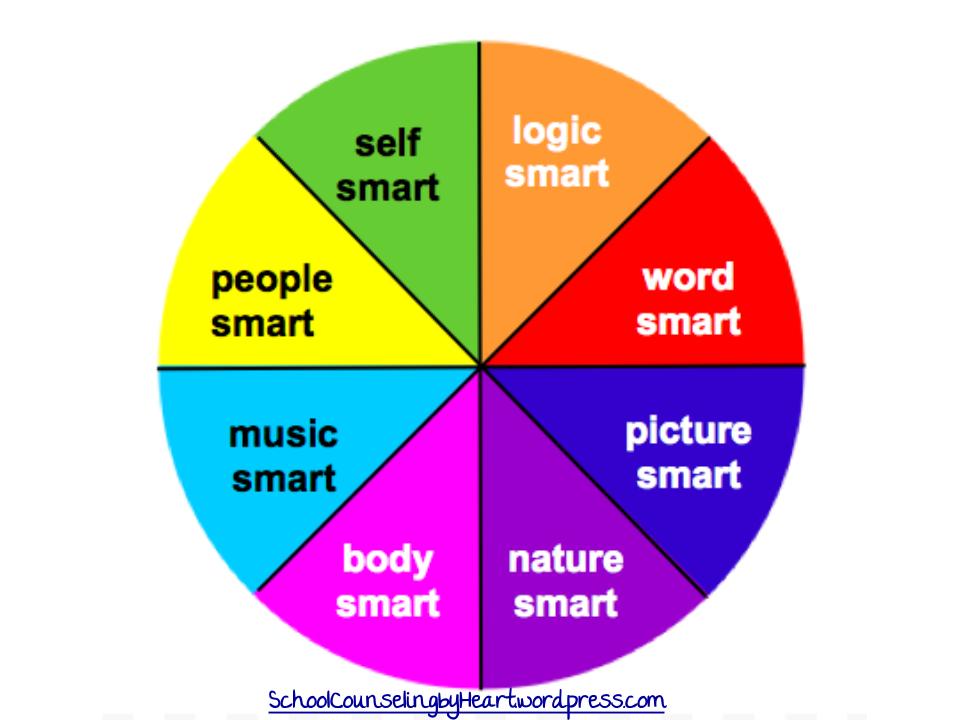 Wow! What amazing feedback I’ve gotten after my last post, Creating CareerSmarts! Thank you to everyone for your kind comments and enthusiasm. I’m so glad that other school counselors (and other educators too!) are excited about using the CareerSmarts lessons and that people are finding the info and resources helpful. As promised, here are the lessons about multiple intelligences. They provide a foundation for the CareerSmarts unit, but could also be used on their own for a multiple intelligences mini-unit for classroom or small group use. To find the applicable ASCA and Common Core standards, check here. There’s a lot in this post, but it includes everything you need to be able to teach these lessons yourself.
Wow! What amazing feedback I’ve gotten after my last post, Creating CareerSmarts! Thank you to everyone for your kind comments and enthusiasm. I’m so glad that other school counselors (and other educators too!) are excited about using the CareerSmarts lessons and that people are finding the info and resources helpful. As promised, here are the lessons about multiple intelligences. They provide a foundation for the CareerSmarts unit, but could also be used on their own for a multiple intelligences mini-unit for classroom or small group use. To find the applicable ASCA and Common Core standards, check here. There’s a lot in this post, but it includes everything you need to be able to teach these lessons yourself.
The first two lessons (45 minutes each) in the CareerSmarts unit introduce kids to the concept of multiple intelligences, or “smarts.” These lessons are important not only because they help kids understand the ways that they are smart, but also because they provide foundational information for them to use throughout the rest of the unit. For every career they explore – through video, search engine, game, or interview – they will be making educated guesses about which multiple intelligences are important to that job. In both projects they create – career trading cards and avatars – they will be including information about how people use their multiple intelligences in their work.
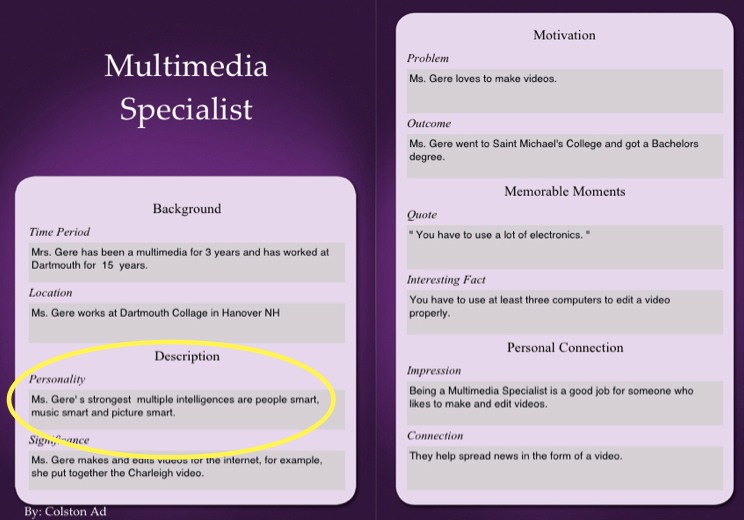
The trading card activity is one example of an activity in which kids use their knowledge of multiple intelligences during the CareerSmarts unit.
Lesson 1: Introduction to Multiple Intelligences
Lesson 1 provides basic information about multiple intelligences and gets kids thinking about how their own and other people’s “smarts” manifest themselves. When I couldn’t find any visual resources I particularly liked, I created a presentation in Google Drive. I had actually intended to create an interactive smartboard lesson, but for reasons which now escape me (icy snow day? home sick? just plain sick of being at school?), but which definitely included a time crunch, I had to create the presentation at home, which meant I had to go to Plan B. “Oh well,” I thought, “it won’t be great, but it will be good enough. I’ll fix it next year.” Little did I know that the kids would really like it, and because I embedded it into the website I created for the unit, they – of their own accord – went back to it and used it as a resource when they were trying to figure out which multiple intelligences matched up with careers they were researching! See, mistakes and running out of time can be good!
Here is the presentation:
[googleapps domain=”docs” dir=”presentation/d/1ZiD9YJkVJWqT_CnzG6vdBxg1oUErIKBabYohcrW5h9U/embed” query=”start=false&loop=false&delayms=3000″ width=”960″ height=”749″ /]
As an introduction to the lesson, I ask the kids for their thoughts about what this statement means:
“The question is not ‘How smart are you?’ It’s ‘How are you smart?”
We check out the first two slides for an overview of multiple intelligences, then look at the information on the slides that explain each of the multiple intelligences. While we read the slides, I ask the kids to think about how they use each of these multiple intelligences, then have them identify some other students in their grade (not themselves) who they notice have a particular strength in this intelligence. I also ask for them to give evidence for why they think this is the case. After we have gotten through all eight of the intelligences, I ask students to identify what multiple intelligences they have seen in the kids that haven’t yet been named.
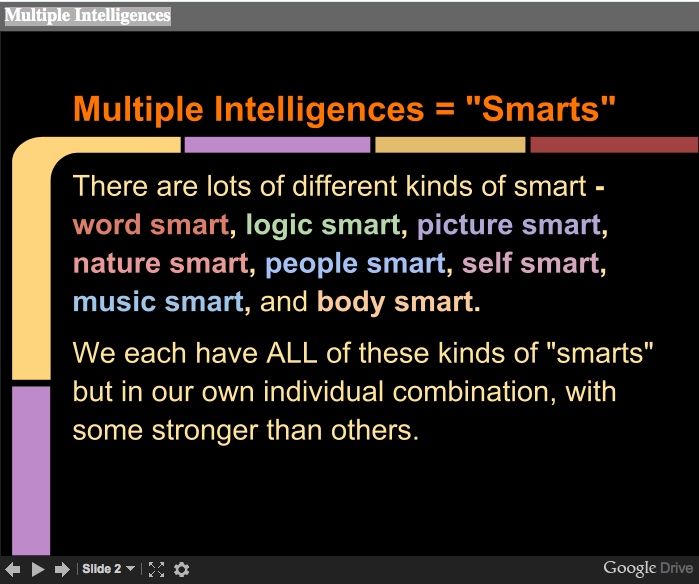 In the next phase of the lesson I introduce the Multiple Intelligences Song video by Les Multibrios, which highlights eight animated kids – one for each “smart” – and which happens to be in French. Yes, in Vermont we are fairly close to Quebec, but, no, my students do not speak French! But that’s okay! I tell them that they need to use their word smarts to read the subtitles and their picture smarts to look for clues about the characters so that they can identify which one represents which multiple intelligence. The kids LOVE this video and the song, which (sorry!) gets stuck in your head – we had a lot of mumble-y fake-French singing over the next couple of weeks!
In the next phase of the lesson I introduce the Multiple Intelligences Song video by Les Multibrios, which highlights eight animated kids – one for each “smart” – and which happens to be in French. Yes, in Vermont we are fairly close to Quebec, but, no, my students do not speak French! But that’s okay! I tell them that they need to use their word smarts to read the subtitles and their picture smarts to look for clues about the characters so that they can identify which one represents which multiple intelligence. The kids LOVE this video and the song, which (sorry!) gets stuck in your head – we had a lot of mumble-y fake-French singing over the next couple of weeks!
We also look at a cartoon about multiple intelligences by the great teacher/cartoonist/musician Marek Bennett, which helps them gather even more info and which they use as another resource later in the unit. To close the lesson I tell them that they will be discovering a lot of information about their own multiple intelligences in the next class. They get all kinds of excited about this! Everybody’s favorite topic – Me!
Lesson 2: Discovering Your Multiple Intelligences
In Lesson 2, students use an on-line multiple intelligences inventory to learn about their own “smarts.” I really like this inventory because it’s quite thorough and the results come back as a colorful, animated pie chart in which each of the smarts grow out from the center – such an exciting reveal! It also allows for a range of ages, so the kids get a chance to check out your (and possibly their classroom teachers’ and parents’) “smarts” too.
I start the lesson by asking the class what they remember about the eight multiple intelligences. As they start sharing information, I tell them they can also look back at the multiple intelligences slides from the previous week. This really gets everyone engaged and helps them better learn the material while feeling successful, because they can find answers to share. (I ask what multiple intelligences they are using to find the info!)
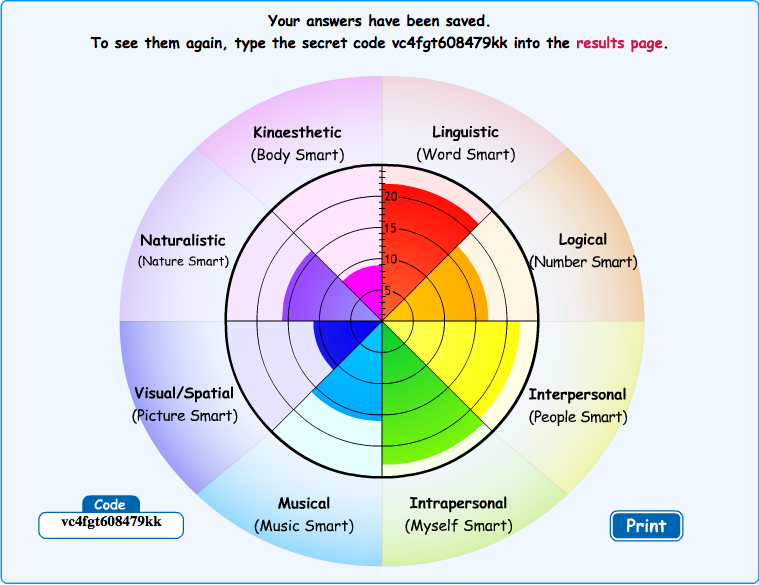
Yup, this is me. Luckily my people smarts are strong, so I guess I’m in the right career! Whew! The P.E. teacher thing was probably not ever going to be a possibility, as you can clearly see.
After the review, I show the kids my inventory results and ask them:
“When you think about what you know about me and the work I do as a school counselor, are you surprised, or do my “smarts” make sense to you?”
This makes for a great, lively discussion as I ask them for evidence of how they have seen my multiple intelligences at work. It also allows me to give examples of how, when I’m trying to understand or figure something out, I am much more likely to use my word smarts (to read about it), logic smarts (to research and make hypotheses), and self smarts (to draw on my experiences) than I am to use my picture smarts (to draw a plan) or my body smarts (to use manipulatives). When they inevitably notice my relatively paltry body smarts, it gives me a great opportunity to model that we all have and use all of these intelligences, even though some are stronger than others. I tell them that even though my body smarts are small compared to my other smarts, they are still there and I use them regularly. I point out that even though I rarely learn by using my hands, and moving around a lot doesn’t help me concentrate, I do use dance as a way to clear my head and de-stress and I am a pretty good actor when we do role plays. I also ask them for advice about how they think I could strengthen my body smarts. I have gotten offers to join in on basketball games at recess, and an invitation to attend P.E. with them – Hah! I’ll have to do a little work on the leftover trauma from old-school, gym-suited days first! This lays the groundwork for them to start thinking about some smarts that they’d like to strengthen.
The rest of the class time is taken up with the kids completing the inventory. Before they start I let them know that they will see that it is called a “test,” but that it really isn’t a test-test. They will be sharing what they know about themselves (in a Likert scale that ranges from “This is not like me at all” to “I am always like this”), so they will definitely always have the right answer. It is important to explain that the results pie graphs are not a measure of how smart you are, they are a measure of how you are smart. The fullness of each section will have to do with how much “like me” they thought the statements were. The results only make sense if you compare each person’s different smarts with each other. It doesn’t actually work to compare one person’s pie graph to another’s.
I give them a heads-up that there are kind of a lot of questions on several pages, but that all they have to do is click on a response, and since they will know the answers, it will go pretty quickly. I also let them know in advance that as soon as they finish they will see their own pie chart grow before their very eyes! A few kids will need some clarification on a couple of questions, and if you have any students who have difficulty reading, you may want to have them complete the survey with you ahead of time (and then help you teach about it) or make plans for yourself or another adult to read the questions aloud to the few who need it.
Be prepared for lots of excited exclamations when the results start coming in! The kids LOVE checking out their own smarts and showing them to their friends. As this great learning hubbub is going on, I ask the kids to think about what they’re seeing about themselves and others makes sense to them and why. The results pie chart comes with a code, which will allow you and your students to retrieve the data any time. I had the kids submit these codes to me via a Google Form that I embedded in the webpage. I then inserted the results into a web page so that they could access their results more easily and look at their friends’ and teachers’ results too. (Our teachers got almost as excited about the inventory and their results as the kids did!)
The Time Glitch
I had originally planned to have another two class sessions devoted to multiple intelligences, but a snow day and field trip meant that we had to move on in order to be prepared for the already scheduled Career Day. I ended up using the lesson in some small groups, which worked well. I will definitely build this back into the unit, because I think the learning from this activity is important, and just leaving off where we did felt unfinished to me. The two lessons we completed prepared them enough to make educated guesses about the smarts required for the careers that they later explored, but I would have liked to have them all make better connections about how they use their multiple intelligences in their daily lives. I’m hoping to be able to pick up and do the third and fourth lessons with the same kids this year, perhaps as a way for them to introduce themselves as learners to their teachers. I’ll keep you posted. Here are the guidelines for the lessons, so you don’t have to wait. They’ve been tested in a small group setting, but I think they will also work well in a classroom setting.
The Tech Glitch
My original plan was to have the students use the iPad app Haiku Deck to create slide shows about their smarts. This was a great plan, but was a bit difficult to execute – Haiku Deck is rated for ages 12 and up, so I couldn’t load it onto our classroom iPads. The reason for this rating (and one of the reasons Haiku Deck is so great) is that it comes loaded with thousands of photos. Most of them are completely harmless, and none of them are completely inappropriate, but unfortunately, some of them are of things like wine glasses and bikini-clad beach-goers, which elementary school students could potentially stumble upon. I thought that maybe it would work if I had the kids take their own pictures instead (a better idea, anyway) but the nice people at Haiku Deck told me there was no way to block the included photos, so the student iPads were a no-go. (Teacher iPads used under supervision are fine, which is what we used in the small groups.) When I do this lesson this coming year, I think I will allow kids to choose their own tool from a list, which may include Book Creator, My Story, Scribble Press, Vine videos, Glogster, iMovie, etc. Another option would be to do it old school and have kids make posters or collages, but the technology piece is so engaging that kids often put more into their work. It’s really too bad that I can’t use Haiku Deck in the classroom, because it really is quite elegant, and perfect for the project.
Here’s the example I made about myself using the pictures within Haiku Deck.
[slideshare id=24820761&doc=mysmarts-1375316031-130731191324-phpapp02]
Lessons 3 & 4: Creating “My Smarts” Presentations
The first step of the project is to have kids do some planning: come up with examples of how they use each of their multiple intelligences, decide how they could show themselves doing so in a series of photos, and write captions for their photos. I encourage kids to refer back to the multiple intelligences presentation if they need help with ideas. Here’s a link to the multiple intelligences planning worksheet.
 The next step is to take the photos and add the captions. I had kids work with partners to set up and take the photos and then type in the captions. It doesn’t take long at all, especially if you partner the kids cleverly. The kids really enjoyed making these, showed a lot of creativity in figuring out how to show their different multiple intelligences, and were proud and excited to share them. Here is one of the presentations:
The next step is to take the photos and add the captions. I had kids work with partners to set up and take the photos and then type in the captions. It doesn’t take long at all, especially if you partner the kids cleverly. The kids really enjoyed making these, showed a lot of creativity in figuring out how to show their different multiple intelligences, and were proud and excited to share them. Here is one of the presentations:
[slideshare id=24822524&doc=jssmarts-1375321975-130731205229-phpapp02]
Stay tuned! Upcoming posts include:
- CareerSmarts Task 2: Web-Based Career Exploration: Student-driven career exploration lessons utilizing videos, a search engine, games, and a nifty gamification incentive
- Coordinating Career Day : Planning, preparatory lesson, interview script, and all the details about how to organize and run Career Day.
- Career Trading Cards: Students create trading cards featuring their Career Day interviewees.
- Kids demonstrate their learning – creating a career avatar, script writing guidelines, tech tools, virtual career fair, and unit data and evaluation.
You might also be interested in:
A Collection of Sexual Abuse Prevention Resources

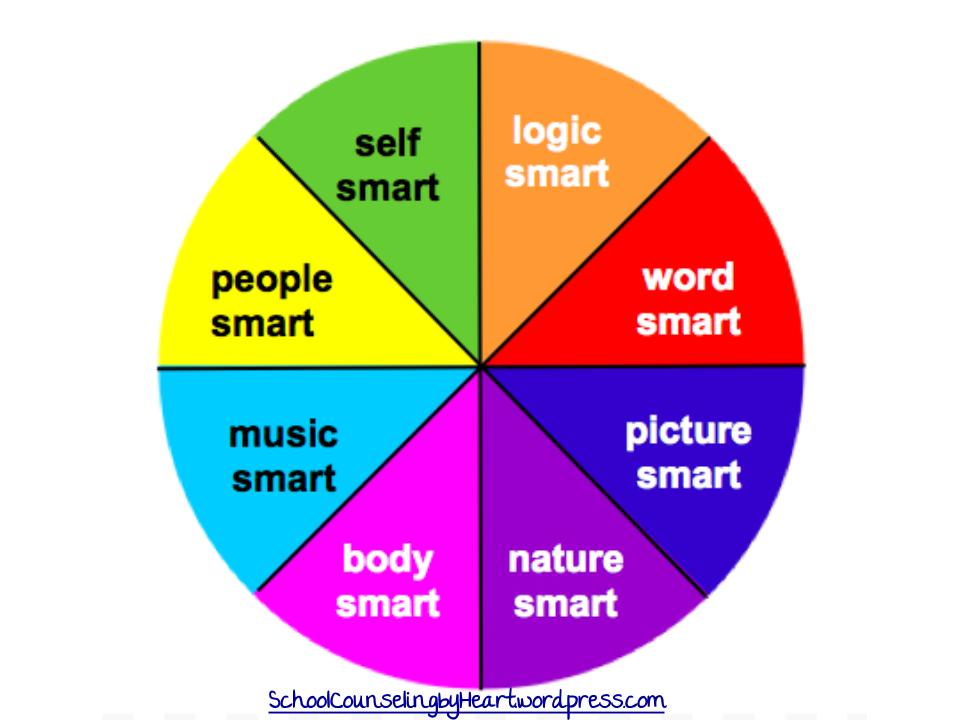
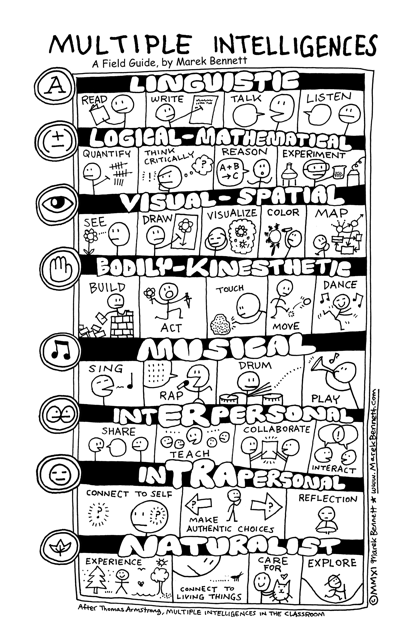
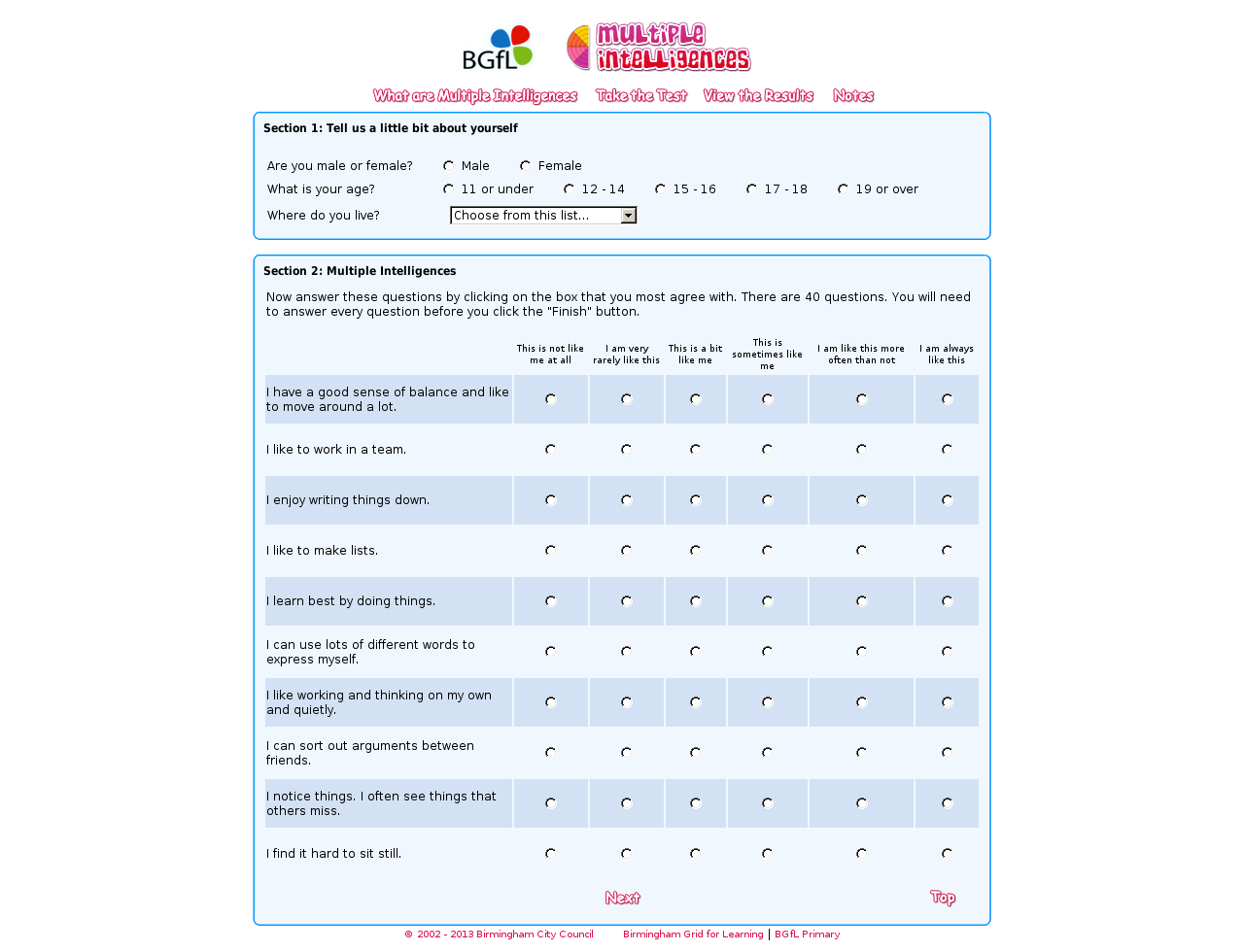

This is wonderful, thank you for sharing! What ages do you use these lessons with?
I did these lessons with fourth graders, but it could be used as is with fifth and modified a bit for sixth grade.
Fantastic! Thanks so much for shaing your ideas and hard work. I am looking forward to your next posts.
Love it! What program did you use to make the slideshows and write the captions? (the example isn’t showing up for me) Thanks!!!
Thanks! I made the slide show with the information about multiple intelligences with Google Presentations, which is part of Google Drive. The slide shows that the kids made of themselves showing how they use their multiple intelligences were created with Haiku Deck. I’m not sure why it’s not showing up for you. Maybe if you view on a different device? The Voki avatars that kids made as the culmination of the CareerSmarts unit can’t be viewed on mobile devices, so maybe something similar is going on here.
I love this! Could you modify this for high school students incorporating the common core?
I’m sure you could. You would just need to look at the high school level common core standards to see what kind of adjustments you would have to make to the lessons.
Rebecca, I have been doing this lesson, and I LOVE IT! Thank you so much for sharing! I have one question: when you had the students submit their code via the Google form to the website, and then inserted the results into the website–can you explain a bit about how you did that? I’ve created the form in Google, but not sure about how to best do the rest (I’m notorious for doing things the absolute hardest way possible). LOVE your blog!
Thanks,Kim! I can’t wait to hear how it goes. I embedded the Google form into the Google Site page. (I just googled how to do it, and can’t remember what the steps were. It was pretty easy, since both are Google tools. You don’t necessarily need to have it there, they could just go to a different survey link, but it did make it less confusing for the kids to have them in one place. Will you let me know how your kids like it, whether you think it was a good learning activity, and how it worked for you?
Rebecca
I am excited to try a version of this with my middle school students! I am wondering what you used for your pretest?
I’ll be sharing my pre- and post-tests in the next couple of weeks. So sorry it’s taking me so long to do these posts. It sure would be a lot easier to blog about being a school counselor if I wasn’t busy being a school counselor!